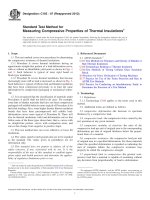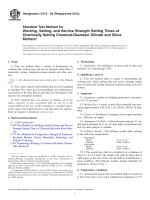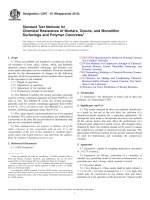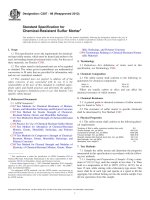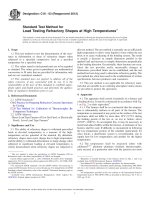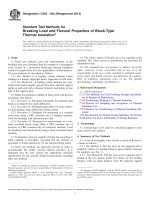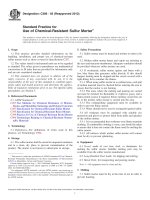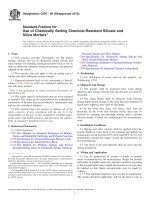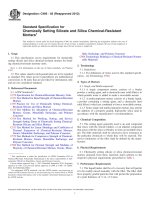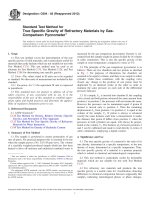Astm c 414 03 (2012)
Bạn đang xem bản rút gọn của tài liệu. Xem và tải ngay bản đầy đủ của tài liệu tại đây (84.1 KB, 3 trang )
Designation: C414 − 03 (Reapproved 2012)
Standard Test Method for
Working, Setting, and Service Strength Setting Times of
Chemically Setting Chemical-Resistant Silicate and Silica
Mortars1
This standard is issued under the fixed designation C414; the number immediately following the designation indicates the year of
original adoption or, in the case of revision, the year of last revision. A number in parentheses indicates the year of last reapproval. A
superscript epsilon (´) indicates an editorial change since the last revision or reapproval.
This standard has been approved for use by agencies of the U.S. Department of Defense.
1. Scope
3. Terminology
1.1 This test method offers a means of determining the
working time, setting time, and service strength setting time of
chemically setting, chemical-resistant silicate and silica mortars.
3.1 Definitions—For definitions of terms used in these test
methods, see Terminology C904.
4. Significance and Use
4.1 This test method offers a means of determining the
working time, initial setting time and service strength setting
time of chemically setting chemical-resistant silicate and silica
mortars.
NOTE 1—For chemical-resistant resin mortars refer to Test Methods
C308.
1.2 The values stated in inch-pound units are to be regarded
as standard. The values given in parentheses are mathematical
conversions to SI units that are provided for information only
and are not considered standard.
5. Apparatus
5.1 Equipment, capable of weighing materials or specimens
to 60.3 % accuracy.
1.3 This standard does not purport to address all of the
safety concerns, if any, associated with its use. It is the
responsibility of the user of this standard to establish appropriate safety and health practices and determine the applicability of regulatory limitations prior to use.
5.2 Mixing Pan—A metal or porcelain enameled pan measuring approximately 8 by 8 by 2 in. (200 by 200 by 50 mm)
deep.
5.3 Trowel—A bricklayer’s triangular trowel approximately
4 in. (100 mm) in length.
2. Referenced Documents
5.4 Aluminum Foil Dish—A flat-bottomed container 21⁄4 in.
(60 mm) in diameter by 5⁄8 in. (16 mm) high. An aluminum foil
dish for milk analysis is suitable.
2.1 ASTM Standards:2
C308 Test Methods for Working, Initial Setting, and Service
Strength Setting Times of Chemical-Resistant Resin Mortars
C579 Test Methods for Compressive Strength of ChemicalResistant Mortars, Grouts, Monolithic Surfacings, and
Polymer Concretes
C904 Terminology Relating to Chemical-Resistant Nonmetallic Materials
5.5 Gillmore Needle— The Gillmore needle shall conform
to the following requirements:
Initial Needle
Weight
Diameter
Final Needle
Weight
Diameter
113.4 ± 0.5 g
0.083 ± 0.002 in.
453.6 ± 0.5 g
0.042 ± 0.002 in.
5.5.1 The needle tips shall be cylindrical for a distance of
about 3⁄16 in. (4.8 mm). The needle ends shall be plane and at
right angles to the axis of the rod and shall be maintained in a
clean condition. The Gillmore needles should preferably be
mounted as shown in Fig. 1.
1
This test method is under the jurisdiction of ASTM Committee C03 on
Chemical-Resistant Nonmetallic Materialsand are the direct responsibility of
Subcommittee C03.01 on Mortars and Carbon Brick.
Current edition approved Aug. 1, 2012. Published September 2012. Originally
approved in 1958. Last previous edition approved in 2008 as C414 – 03 (2008).
DOI: 10.1520/C0414-03R12.
2
For referenced ASTM standards, visit the ASTM website, www.astm.org, or
contact ASTM Customer Service at For Annual Book of ASTM
Standards volume information, refer to the standard’s Document Summary page on
the ASTM website.
6. Temperature Conditions
6.1 All material used in this test method shall be stored for
at least 16 h prior to use at the standard test temperature of 73
Copyright © ASTM International, 100 Barr Harbor Drive, PO Box C700, West Conshohocken, PA 19428-2959. United States
1
C414 − 03 (2012)
FIG. 1 Gilmore Apparatus
Needle, having a tip diameter of 1⁄24 in. (1.06 mm) penetrates
the sample 3⁄16 in. (5 mm), the length of the needle tip, in 1 min.
6 4°F (23 6 2°C). The standard temperature for the working,
initial setting, and service strength setting times shall be 73 6
4°F.
NOTE 2—In order that sufficient data will be obtained with the sample,
it is suggested that tests be made at maximum time intervals of 30 min
until the needle takes 15 to 30 s for penetration; then the tests can be
repeated at more frequent intervals, as the time for penetration nears 60 s.
6.2 The relative humidity of the surrounding air shall be
kept below 80 % during mixing of the mortar and conditioning
of the specimens.
8.3 Service Strength Setting Time, Compressive—In accordance with Test Method C579, make a minimum of three test
specimens for testing at each time interval; this normally
requires a minimum of twelve specimens. Test three specimens
on the seventh day after preparation in accordance with Test
Method C579 and continue testing every 48 h until the average
compressive strength of the three test specimens at the respective time interval reaches 90 % of manufacturer’s published
compressive strengths when tested at 73 6 4°F. Other test
temperatures are acceptable as agreed upon by the user and
manufacturer. They shall agree on an acceptable time,
temperature, and compressive strength percentage criterion for
service strength setting time as applies to their specific application.
6.3 Other test temperatures are acceptable upon agreement
between the manufacturer and user, provided that they are
reported with the test data.
7. Preparation of Mortar
7.1 Prepare a 4.4 lb (2000 g) sample of mortar using the
proportionate amounts of powder filler and liquid recommended by the manufacturer. If the proportions are specified by
volumes, weigh the volumes and report the corresponding
weights. Pour the liquid into the mixing pan and gradually add
the powder filler to the liquid while mixing with the trowel.
Note and record the time mixing begins. Thoroughly mix the
mass until a uniform mixture is secured. The total mixing time
shall be in accordance with the manufacturer’s recommendation.
9. Report
7.2 Fill an aluminum dish and strike off the surface evenly
with a straight-edge spatula. Spread out the remainder of the
mortar in the mixing pan to a uniform thickness.
9.1 Report the following information:
9.1.1 Manufacturer’s name of mortar and generic type,
9.1.2 Mixing ratio and component weights,
9.1.3 Test conditions (temperature and humidity),
9.1.4 Working time (minutes),
9.1.5 Initial setting time (hours),
9.1.6 Manufacturer’s published compressive strength,
9.1.7 Service compressive strength setting time (days).
9.1.8 Report the compressive strengths determined at the
respective time intervals.
7.3 Prepare test specimens in accordance with C579 if
service strength setting time is to be determined.
8. Procedure
8.1 Working Time— Remove approximately 0.5 oz (15 g)
portions of the silicate or silica mortar at 5-min (maximum)
intervals and trowel onto a smooth, clean and dry horizontal
surface. Before taking the 0.5 oz portions, work the trowel
through the mix to work in any skin that may have formed on
the surface. Consider the mortar workable if it stays in the
applied position without following the trowel or without
curling behind the trowel while spreading. Record the working
time as the time in minutes from the start of mixing the filler
and binder until the mortar ceases to be workable and fails to
stay in the applied position while spreading. Do not return the
material used for tests to the mixing pan.
9.2 If test temperatures or other test criteria are different
than so stated by the test method, then same shall be reported.
10. Precision and Bias
10.1 Precision and bias for this test method have not been
established.
10.2 To obtain sufficient results to make a statement of
precision and bias, repeat Sections 6, 7, and 8 at least three
more times.
8.2 Initial Setting Time—Test the specimen in the aluminum
dish (see 7.2) for penetration by the Gillmore needle. Record
the initial setting time as the time in hours from the start of
mixing the filler and binder until the 1 lb (454 g) Gillmore
10.3 Test results that are manifestly faulty or that give
values differing by more than 15 % from the average value of
all respective results obtained when using the same mortar
2
C414 − 03 (2012)
components and tested at the same temperatures shall not be
considered in determining the average working time, initial
setting time, or the service compressive strength setting time.
If, after discarding values, there are less than three remaining
for determination of the working time, initial setting time, and
the service compressive strength time, a retest shall be made.
11. Keywords
11.1 chemical-resistant; mortars; service strength setting
time; setting time; silica mortars; silicate mortars; working
time
ASTM International takes no position respecting the validity of any patent rights asserted in connection with any item mentioned
in this standard. Users of this standard are expressly advised that determination of the validity of any such patent rights, and the risk
of infringement of such rights, are entirely their own responsibility.
This standard is subject to revision at any time by the responsible technical committee and must be reviewed every five years and
if not revised, either reapproved or withdrawn. Your comments are invited either for revision of this standard or for additional standards
and should be addressed to ASTM International Headquarters. Your comments will receive careful consideration at a meeting of the
responsible technical committee, which you may attend. If you feel that your comments have not received a fair hearing you should
make your views known to the ASTM Committee on Standards, at the address shown below.
This standard is copyrighted by ASTM International, 100 Barr Harbor Drive, PO Box C700, West Conshohocken, PA 19428-2959,
United States. Individual reprints (single or multiple copies) of this standard may be obtained by contacting ASTM at the above
address or at 610-832-9585 (phone), 610-832-9555 (fax), or (e-mail); or through the ASTM website
(www.astm.org). Permission rights to photocopy the standard may also be secured from the Copyright Clearance Center, 222
Rosewood Drive, Danvers, MA 01923, Tel: (978) 646-2600; />
3
